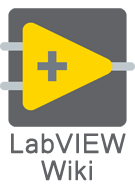VI Icon: Difference between revisions
Appearance
m Move to Category:VIs |
|||
| (8 intermediate revisions by one other user not shown) | |||
| Line 1: | Line 1: | ||
{{ | The '''VI Icon''' is used to represent the function of the [[VI]] as a [[SubVI]] on the [[Block Diagram]]. | ||
{{TOCright}} | |||
== Best Practices == | |||
The icon you use to represent your [[SubVI]] can tell you or other developers a lot about what the [[SubVI]] does without ever having to open the [[SubVI]]. Taking the time to create at least simple text VI icon is a requirement when sharing code between developers. The use of images in VI icons can also enhance their meaning when text can't be used because of length or in cases where code is shared across different spoken languages. National Instruments keeps an [http://www.ni.com/devzone/idnet/library/icon_art_glossary.htm Icon Art Glossary] to help developers who are less experienced making easy to recognize icons. | |||
== VI Icon | == Editing the VI Icon == | ||
See [[Icon Editor]]. | |||
== | == History == | ||
{| class="wikitable" | |||
! Version | |||
! Change(s) | |||
|- | |||
| [[File:LV8-2013.png|frameless|border|64x64px|LabVIEW 2012|link=LabVIEW 2012]] | |||
| In [[LabVIEW 2012]] the [[Icon API]] is released as [[Class (object-oriented programming)|Object-Oriented Classes]]. It allows for scripting Icons with access to Text, Glyph, and user layers. | |||
|- | |||
|[[File:LV8-2013.png|frameless|border|64x64px|LabVIEW 2011|link=LabVIEW 2011]] | |||
|In [[LabVIEW 2011]] the Connector Pane was changed to always be visible on the [[Front Panel]] window next to the [[VI Icon]]. [[LabVIEW 2010]] and earlier only the Connector Pane or the [[VI Icon]] was visible at a time and they were toggled between via a right-click menu ('''Show Connector''' or '''Show Icon'''). | |||
|} | |||
== See Also == | |||
* [[Icon API]] | |||
[[ | |||
[[Category:LabVIEW fundamentals]] | [[Category:LabVIEW fundamentals]] | ||
[[Category: | [[Category:VIs]] | ||
Latest revision as of 16:49, 7 August 2024
The VI Icon is used to represent the function of the VI as a SubVI on the Block Diagram.
Best Practices
The icon you use to represent your SubVI can tell you or other developers a lot about what the SubVI does without ever having to open the SubVI. Taking the time to create at least simple text VI icon is a requirement when sharing code between developers. The use of images in VI icons can also enhance their meaning when text can't be used because of length or in cases where code is shared across different spoken languages. National Instruments keeps an Icon Art Glossary to help developers who are less experienced making easy to recognize icons.
Editing the VI Icon
See Icon Editor.
History
| Version | Change(s) |
|---|---|

|
In LabVIEW 2012 the Icon API is released as Object-Oriented Classes. It allows for scripting Icons with access to Text, Glyph, and user layers. |

|
In LabVIEW 2011 the Connector Pane was changed to always be visible on the Front Panel window next to the VI Icon. LabVIEW 2010 and earlier only the Connector Pane or the VI Icon was visible at a time and they were toggled between via a right-click menu (Show Connector or Show Icon). |
